Iran and Central Asia Tour Program

Day 1 Arrival Shiraz
You arrive in Shiraz. Very nice welcoming city with friendly people and you will be amazed how these people can enjoy their lives. You see many people on the street eating and drinking and in the evening they make picnic dinner in any green spot they find in the city.
Shiraz was the capital of the Zand dynasty, therefore many sites in the city belong to that era. You can visit Arg-e Karimkhan, in the downtown of Shiraz at the beginning of Karimkhan Zand street. Not far from Arg you can find Vakil Bazaar and also Vakil Hammam and Vakil mosque is near to you. The whole part is called karimkhan complex. You may spend the whole afternoon in this part of the city and you have time to stroll in Bazaar and sit in a café in Saray-e Moshir and order a herbal drink or Faloodeh ( a traditional shirazi cold dessert… I do not tell you more cause you have to try it)

Day 2 Shiraz
It is really good to start such wonderful trip in Shiraz. The rhythm of life in this beautiful city is delicately slow & easy, people are very warm and friendly, and nothing won’t stop them of starting a friendly conversation with you and a warm welcome. As this city has a rich background in poetry and literature, many famous Persian poets were from Shiraz, that’s why you may see that shiraz is introduced as the city of rose and nightingale. Beautiful gardens, good weather, smell of blossom, cold herbal drinks (you should try some in Bazaar or tea houses) and previously Shiraz Wine make you feel like a poet and maybe you start to write some lines.
We suggest you start your tour in the morning and first a visit to Nasir-al molk mosque known as Pink Mosque, because of the usage of a considerable number of pink-colored tiles for its interior design. Also, its stained-glass façade with the reflection in the morning, makes you just say Wow and take 1000 of pictures. Since Shiraz was the capital of Persia during Zand dynasty, you will see more monuments of this era. Karimkhan Complex including shiraz famous Bazaar. You can visit tomb of two Poets that they have the worldwide fame, Tomb of Poet Hafez and Sa’adi. A visit to Eram Garden specially in May with the smell of orange blossom should not be missed. As you may already noticed, people of shiraz enjoying a lot eating out and having fun outside. In the evening you see many people are having picnic dinner in any green space they can find in the city. Families are together and kids playing. Also, there are many good restaurants with live music that you can go for the last dinner in Persia.
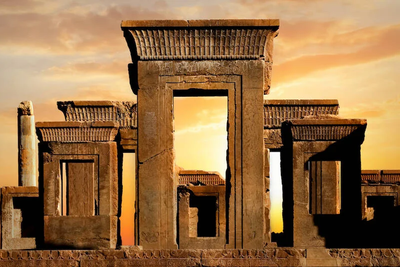
Day 3 Shiraz - Persepolis
Not far from Shiraz you will find the most important monument of ancient Persia. In about one hour you will be in Persepolis, the ceremonial capital of Achaemenid Empire, located on the foothill of Rahmat Mountain. Persepolis was built mainly during the Darius I. Persepolis was a spring/summer royal residence and seems to have been intended as a ceremonial center where representatives of subject states came to pay respects to the king. The complex has nine structures that you can visit. Some parts of them are still after invasion and natural destruction such as the Gate of all Nations, The Apadana staircase and Apadana palace, Palace of Darius I, Palace of Xerxes and Achaemenid Kings. Not far from Persepolis you will visit Necropolis (Naghsh-e Rostam). Naghsh-e Rostam is the necropolis of Achaemenid dynasty. There are four large tombs cut high into the cliff's face. There are also some reliefs below the tombs from the Sassanid dynasty. You will sleep in a hotel near Persepolis and are lucky enough to have a room facing Persepolis and enjoy the sunset view over the remains of Achaemenid Empire.

Day 4 Persepolis - Yazd via Pasargad and Zein-o Din
You continue to Pasargadae, the first capital of Achaemenid Empire built by the order of Cyrus the Great. The most important monument in Pasargadae is the tomb of Cyrus the Great .
To get refreshed after sometimes sitting in the car you may like to stop in Abarkuh and not to miss the chance to see the ancient living cypress tree which is estimated to be over four millennia old. Abarkuh also has 4 adobe ice reservoirs.
A special experience in the afternoon, you will have lunch in the ancient caravanserai of Zein-o Din. This is one of the best-preserved caravanserai in Iran and one of the few with a round shape; it is now used as hotel.
At the end of the afternoon you arrive in Yazd, one of the most beautiful cities of Iran and one of the bests to stay, with its beautifully preserved old town. There are several restaurants, tea shops, hotels and shops.

Day 5 Yazd
Yazd has a unique architecture adopted to its desert climate. In the city of windcatchers you see how these people could manage to have natural ventilation system to chill the hot days of summer inside their houses.
Yazd houses remarkable number of Zoroastrians, and you will start your city tour with visiting of Zoroastrian Fire Temple, the sacred fire of the temple is stated to have been burning since about 470 AD.
After Fire Temple you will visit Dowlat Abad Garden, as the sample of Persian garden Dowlat Abad was also built with residential purpose and the tallest windcatcher has been built in the center of the garden.
Walking in the old town, Yazd Jame Mosque & Amir Chakhmaq façade can be visited in the afternoon.
Yazd also has a nice Bazaar and its silk textile (Termeh) is very much famous worldwide, even Marco Polo in his visit in 1272 has remarked the city fine silk-weaving industry. Take a walk in Bazaar and enjoy seeing colorful Termeh hanging on the walls in front of each shop.
One special activity to see in Yazd in the evening is going to Zurkhaneh, Traditional gymnasium in which Varzesh- Bastani (ancient sport) is practiced. Ancient Sport is a traditional system of athletics originally used to train warriors in Persia.

Day 6 Yazd - Isfahan via Na' in
Today you will travel to Iran's most famous city; Isfahan. On the way you can have a stop in the small city of Na'in. Like much of the Iranian Plateau Na'in has desert climate. Due to this kind of climate Iranian many years ago learnt how to construct aqueducts underground (Qanats) to bring water from the mountains to the plains. Na'in is one the best places to see these qanats. Nain also has some few outstanding monuments, Jame mosque of Na'in is among the oldest ones in Iran. Na'in is also very famous with its textile and carpet workshops.
End of the day you arrive in Isfahan. This beautiful city is the culmination of the Persian culture, with its many mosques, palaces, gardens, madrasa and bazaars. You will have at least enough time to see everything, to strike up a conversation with a curious 'local' and looking for some souvenirs at the bazaar. Maybe you will take a Persian carpet home.

Day 7 Isfahan
First day of your tour in amazing city of Isfahan where you find yourself walking in boulevards surrounded by beautiful gardens and splendid art and architecture masterpieces.
This city is famous with its Persian – Islamic architecture and one of the largest city squares, Naghsh-e Jahan square. Your city tour will start with visiting this famous and truly beautiful square, that you will find Sheikh Lotfollah Mosque on its eastern side, this mosque was built during Safavid dynasty, Shah Abbas I and was a private mosque for the royal court.
The next monument is Imam Mosque (formerly Shah Mosque) on the south side of the square also built under the order of Shah Abbas I considered as one of the masterpieces of Persian architecture. Next site, opposite to Sheikh Lotfollah Mosque is the imperial Palace of Ali Qapu, the best example of Safavid art and architecture. Now time for one of the oldest Bazaar in Isfahan, Qeysarie Bazaar in the north side of the square. The entrance of Bazaar is full of paintings and you will be amazed by high ceiling and all the art details you find on the roof. You can find different shops both side and it can be a best place for buying souvenir; Persian carpets & rugs, miniature, calligraphy, tile work… or siting in one the tea houses to get refreshed.
Among other places you can visit in the afternoon Chehel Sotoun is highly recommended, this Pavilion that was built under the order of Shah Abbas II is in the middle of a park and used for his entertainment. After visiting the Chehel Sotoun and its collection of paintings that each has its story you can sit in the its park and enjoy a cup of tea.
In the evening you will enjoy the city on your own, having dinner in one of the many local restaurants that all of them serve high quality food and no matter where your hotel is located, you can always find some of these good places easily.

Day 8 Isfahan
You wake up again in Isfahan while your head is still full of those dreams you had last night of all the eslimi patterns, miniature, frescos… and still another day.
Isfahan is also famous for its Zayandehrood, the largest river of the Iranian Plateau. Anywhere is a river there are some bridges and bridges in Isfahan are among the most beautiful ones. There are eleven historical bridges over Zayanzehrood. You will visit 2 of them. Allahverdikhan Bridge popular as Si-o Se Pol is the largest one. The next bridge is Khaju Bridge, in words of Arthur Pope and Jean Chardin, Khaju is "the culminating monument of Persian bridge architecture and one of the most interesting bridges extant ... where the whole has rhythm and dignity and combines in the happiest consistency, utility, beauty, and recreation.
Isfahan also has great number of Armenian population. You will have a visit to Armenian Quarter in Jolfa district and will visit Vank Cathedral and its museum. While you are walking in streets and alleys of Jolfa you can smell coffee, no wonder, you can find many of coffee bars here and all serve nice coffee. Jolfa is also very nice part of the city to spend your evening. Many young people will come for dinner here and you see a lot of street food and also good restaurants.

Day 9 Isfahan - Kashan via Abyaneh
On the way to Kashan you will visit Abyaneh village. Abyaneh is one of the oldest villages in the country and each year hosts a lot of visitors, foreigners or domestic, especially during traditional ceremonies.
People of Abyaneh preserved their tradition persistently, you can see it in the customs of women. Women wear long floral scarves and colorful skirts. Abyaneh is also known as the Red Village because of its red clay architecture. You can enjoy an hour of walking in the village and also do not miss the mosque with its wooden mihrab. In the evening you will be in Isfahan and you have time to make a panoramic tour of the city but keep the best part for tomorrow.

Day 10 Kashan
Kashan, a small oasis town with its very well-taste wealthy merchants who built marvelous houses that you like to spend hours and hours to see all the detailed work of art in every corner. The most famous houses of these merchants are close together, not far from your hotel. You can see amazing stained glass windows in beautifully decorated rooms at Tabatabai house or in the house of Samovar Merchant, Mr. Broujerdi, you can find masterpieces of frescos made by famous Iranian artist, Kamal- al molk. Nearby you can visit one of the finest hammams, (traditional bath) which today does not have its function as hammam but still a splendid site to visit; Hammam-e Sultan Ahmed that features multiple rooms of beautifully- colored tiles. Another important site to visit is Fin Gardens. The origin of the garden is prior to the Safavid period and developed by Shah Abbas II and highly recognized during Qajar. Fin Gardens is not only one of the best samples of Persian garden in its structure it also was witness one of the saddest event of Qajar period. Amir Kabir, the Qajarid chancellor, who was well-known for his justice and knowledge was murdered by an assassin send by King Nasereddin Shah in 1852. So far all the places you visit are not dating back to far history. You will be amazed to know in a suburb of the city of Kashan there is a historical site, called Sialk Hill with the history dated back to 6000- 5500 BC.
Back to the city you will love to rest in the yard of your charming hotel with fountain in the middle and trees around. Drink tea or cold herbal syrup.

Day 11 Kashan - Tehran via Qom
Today you will leave for Tehran, the buzzling capital of Iran. On the way you have Qom and in case of your interest you can stop and see this city. Qom is the center of the Islamic revolution and the city of mullahs, the muslim clergy. Here you can visit the Shrine of Hazrat-e Masumeh, sister of Imam Reza. This Shrine is one of the most important pilgrimage sites for shiites. Once you are in front of the mausoleum you will find yourself in another world. You can only see women in black chador and mullahs and a huge number of pilgrimages from all over Central Asia and the Middle East. It’s a beautiful sight, right in the heart of shiite Islam. In the center of this huge complex is the mausoleum of Hazrat-e Masumeh , which everyone touches.

Day 12 Tehran
Today a visit of the capital city, Tehran, the largest metropolitan city in the Middle East. Tehran never sleeps. This large city during recent history of Iran was the home of very important events. To discover Tehran and its different lives and lifestyle one day is not enough. You will be amazed how tradition and modernity come together and make the structure of this city. There is plenty to do and see in Tehran. Depends on what you like to do, Tehran can offer you many of interesting museums, traditional and local bazars, modern shopping centers, galleries of modern art, parks, mountains, ski resort in the season, historic buildings, modern architecture, street foods, hipster café , high-end classy restaurants … for a classic city tour in Tehran we may suggest you to have a visit of National Museum. This museum has two exhibitions, The Museum of Ancient Iran and the Museum of Islamic Art and Architecture. We may suggest you to pay a visit to this museum in order to have a general idea of what you will visit on your next days of your travelling.
The other place which can be suggested is the Golestan Palace , which is one of the oldest historic places in the city and formerly was the royal Qajar complex. The complex of Golestan Palace consists of 17 structures, including palaces, museums, and halls. Golestan palace has a collection of Iranian crafts and European presents from the 18th and 19th centuries. If it fits to your program do not miss Treasury of National Jewels and be fascinated by all the gemstones and the history behind each piece. The Grand Bazaar of Tehran is one of the places you should visit. Tehran Grand Bazaar splits into several corridors and each specializes in different types of goods. So far you are in the old part of Tehran, to get some idea about the modern part of the city you should drive to north of the city and spend some times in Nature Bridge (Pol-e Tabiat) and sit and relax in one of the many cafes and get refresh while you have a view of Tehran.
This list is few places in Tehran that you can visit. You can always ask us for more detailed information.

Day 13 Tehran - Mashad
You will make a wonderful train journey passing the Alborz mountains along the Caspian Sea. Total journey will be around 11 hours and in the end of the day you reach the holy city of Mashad.

Day 14 Mashad
The city Mashad itself was not a famous city in ancient time and gained all its fame after the martyrdom of Imam Reza, the 8th Imam of Shia Muslim, who is buried in this city. Every year millions of pilgrimages visit Imam Reza Shrine. Because of so many visitors Mashad has huge number of hotels, specially the most luxurious ones, after some nights in rural homestays maybe a bit of luxury is not that bad!
In Mashad beside the Shrine of Imam Reza, you can visit the museum of Astan-e Qods Razavi which mostly related to Islamic period. You can visit a valuable collection of ancient Qurans. And you can visit the masterpieces of famous calligrapher Reza Abbasi belongs to Safavid era. Rugs and woven textiles in this museum are also interesting artefacts to see.
The other monument that catches your eyes is Goharshad mosque, in the south side of the shrine. This mosque was built during Timurid period under the order of Goharshad, Shahrukh’s wife. The elegance and beauty of the titles, calligraphy and architectural style makes this masque as one of the masterpieces of Iranian architect in Timurid period and due to the closeness to shrine of Imam Reza, this mosque is one of the most visited mosques in Iran. The other places you may like to visit in Mashad are Nadir Shah Afshar Tomb and Darougheh House.
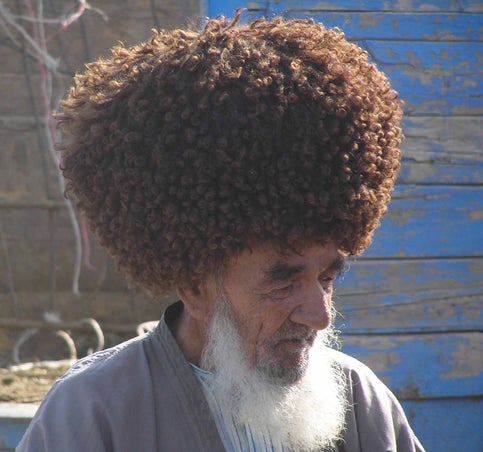
Day 15 Mashad - Mary
It's time to say goodbye to Iran and be welcomed in a new country; Turkmenistan. You will travel to the border of Sarakhs. After visa procedures you will be welcomed by our team from Turkmenistan. You will be driven to the town of Mary.
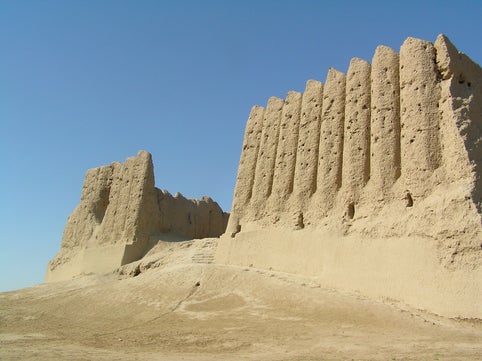
Day 16 Mary - Merw - Buchara
You will start the day by visiting one of the legendary cities of the ancient Silk Road: Merw. A huge area of ancient ruins, with a few protruding buildings. One of the most distinctive buildings is the Kyz Kala palace, used from the 7th to 11th centuries. Dromedaries usually graze around the palace. The city was built in the 6th-century BC as part of the Aechemenid empire. That empire was defeated in the 3rd-century BC by Alexander the Great, although it is uncertain whether he himself visited Merw. Subsequently, the city became one of the most important centers in the empire of the Seleucids, the Bactrians, the Parthians and the Sassanids.
In the 11th century, the city revived as the eastern capital of the Seljuk Empire and even grew to become one of the most important cities in the Islamic world. But eventually this city too fell to the destructive power of Djenghiz Khan and his Mongol troops. Since then, the city has been at the mercy of the desert sands. Not surprisingly, a city with such a rich past actually consists of many cities, each recalling a different era. And much of the past is still buried underground. But even now you can feel the history shimmering through the desert heat.
You will continue your journey through the desert of Turkmenistan towards Turkmenabad and the border with Uzbekistan. Along the way you will pass the Repetek Nature Reserve. At Turkmenabad you will cross the Amu Darya to the border town of Farab and return to Uzbekistan. After border formalities, the Uzbek driver will be waiting to take you to Buchara.
Located on the edge of the Kyzylkum Desert, Buchara is probably the city that will appeal most to travelers. The many mosques and madrasahs may not match the splendor of those in Samarkand, but the atmosphere exuded by the old city, with its narrow streets, mud houses and blue domes, ensures that one can imagine oneself centuries back here. Not for nothing was it said of "Buchara al Sharif" ("the Noble One") that the light here shines from below to above, rather than the other way around. With its many mosques and madrasahs, this was the holiest city in Central Asia.
You can spend hours wandering the narrow alleys of the old city. There is something new to discover everywhere; in addition to the well-known structures, there are dozens of unnamed remains of mosques, madrasahs and caravanserais. However, Buchara is not just a city of structures; people live and work everywhere among the ancient monuments. This makes it all the more interesting to get yourself lost in this ancient labyrinth.
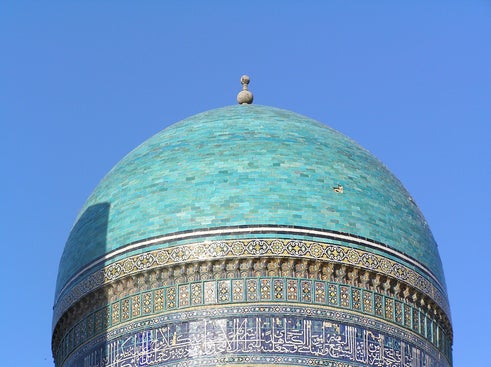
Day 17 Buchara
Today you can spend the whole day exploring this city. In fact, all the sights are within walking distance of each other. Visit the Samani mausoleum and the Chasma Ayub, the source of Job. A tour of the Ark, the ancient fortress, should not be missed. Stroll through the bazaar and visit the many madrasahs.
The Poi Kalyan ensemble is the religious heart of Buchara. The Kalyan Mosque dates back to 1514 and is the second largest in Central Asia. The mosque measures 127 by 78 meters and can accommodate 12,000 worshippers. Opposite the mosque is the Mir-i-Arab madrasah, with two striking turquoise domes.
Not far behind the Pol Kalyan ensemble are the Ulugh Bek madrasah and the Abdul Aziz madrasah. One of Buchara's oldest buildings is the 12th-century Magok-i-Attari mosque. This is one of the few remaining structures of the Karakhanids. The mosque was built on a site previously occupied by a Buddhist temple, a Zoroastrian temple and a mosque built by the Arabs. Of the original structure, only the south gate and foundations now exist; the rest dates back to the 16th century.
The center of the old city is the Lyab-i-hauz ("bank of the basin"). A u-shaped complex was built here in 1620, which inspired the Registan in Samarkand. The madrasah is strikingly decorated with white birds. Inside are now souvenir stores and some workshops. In front of the madrasah is the statue of Khodja Nasruddin, a 13th-century Turkish Sufi saint whose stories laced with humor and optimism are still used in children's stories. All structures notwithstanding, the Lyab-i-hauz should be visited mainly for doing nothing. Drink tea inde chaikhana or sit on a bench in the shade and watch the people spend the day playing games and exchanging news. In the Lyab-i-hauz you will get the feeling that life here has gone on the same way for centuries.
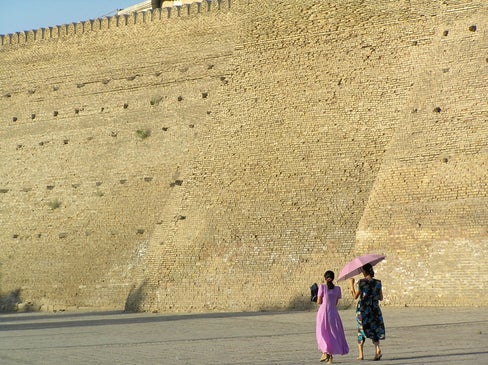
Day 18 Buchara
The surroundings of Buchara also have much to offer. During a half day tour you will see a number of sights outside Buchara:
- the Sitotai Mokhi Khosa (old summer palace of the emir full of paraphernalia),
- the Bolo Khauz mosque, with mausoleum complex of Chor Bakr.
- the impressive Sufi complex of Naqhsbandi. The liberal Sufis kept Islam alive during Soviet rule. It is an impressive complex honoring one of the most important saints for Sufis.
Rest of the day you can explore the old city of Buchara.

Day 19 Buchara - Samarkand
By comfortable train you will travel to Samarkand; there are several trains each day. We try to reserve seats on the super-fast Afrosiab train.
The monumental buildings of Samarkand are the most evocative remnants of Uzbek history. Here you can admire the architectural highlights of the Timurid era. One of the oldest cultural centers in the world, this city, whose name means "fertile settlement," has always played a significant role in the history of Central Asia. Alexander the Great and Djenghiz Khan stood at its gates, and it was the capital of Timur Leng's empire. Trade brought prosperity to Samarkand and the Zerafshan supplied the city with water, making it one of the most pleasant cities in Central Asia. A city whose beauty inspired many poets over the centuries, including Oscar Wilde, Keats, Edgar Allen Poe, Hafez and Omar Khayyam.

Day 20 - 21 Samarkand
Two days to explore Samarkand. The most famous square in Uzbekistan and Central Asia, and one of the most beautiful in the world, is Registan Square. This square in the center of the city is surrounded by three madrasahs. We recommend visiting this square several times a day. This is because you will see how the sunlight gives a different dimension to this fabulous square each time.
Within walking distance of the square are several other sights of this city. The Gur Emir is one of the most monumental buildings of the Timurid era. Timur Leng himself is buried in this mausoleum. Also be sure to visit the bazaar and the adjacent Bibi Khanum Mosque, a huge structure. A little further on, on a hill at the edge of the former Afrasiab, is the complex of Shah-i-Zinda, equipped with the most beautiful mosaic work Uzbekistan has to offer. This necropolis (city of the dead) contains many magnificent mausoleums. While walking, you will see the evolution of local architecture of the 14th and 15th centuries. While the oldest buildings are still simple mausoleums with one room under a dome and a vestibule, the later buildings were given multiple domes and the portal became an increasingly important part of the mausoleum, thus becoming an example of high quality architecture.
Samarkand is not only the city of beauty, romance and poetry, it is actually an "ordinary Soviet city. A Russian city has risen up around its monumental buildings, taking away much of its romantic past. But those who walk along the Registan or through the Shah-i-Zinda soon forget the city around them and can be carried away by the beauty of these ancient structures.

Day 22 Samarkand - Tashkent
Another comfortable train journey will bring you to the capital of Uzbekistan and the last place to be visited on this tour.
In the afternoon time to explore the city. Visit one of the various museums or the colorful Chorsu bazar.
Tashkent is a city where the Soviet past is still clearly visible; it is a grand city with huge squares, wide streets and imposing government buildings. the central Amir Timur square is adorned by a huge statue of this harsh leader of yesteryear. In the old part of the city you will find the round dome of the Chorsu bazaar, next to the Friday mosque and the Kukeldash medressa.

Day 23 depart Tashkent
An escorted transfer based on your flight time will be arranged to the airport…. Have a safe flight